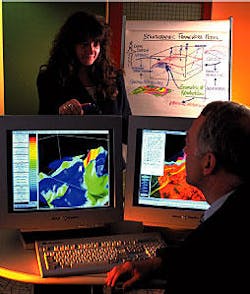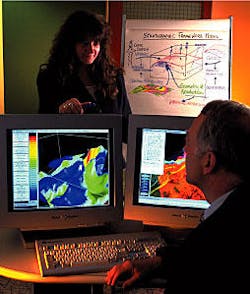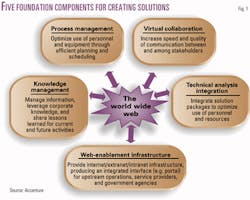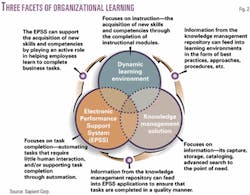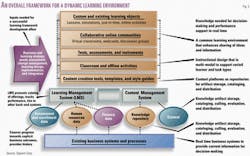Managing Data & Knowledge: Oil, gas industry makes advances in managing data, knowledge
Oil and gas companies continue making strides in better managing both data and knowledge. Gains in managing and retaining institutional knowledge are evident amid a backdrop of some formidable challenges. These include:
- A workforce fast approaching retirement age. With the loss of these workers over the next decade, many industry sources fear the loss of vital institutional knowledge.
- Competition for workers from outside industries. Oil and gas companies are finding themselves with a new challenge: to remain technologically competitive with other high-tech jobs.
- Dispersing knowledge. Companies are taking it upon themselves to train and develop employees.
- Consolidations. With all companies keeping a closer eye on their profit margins, mergers and other consolidations are expected to continue to wreak havoc on displacing, and further disgruntling, an already jarred industry.
Nevertheless, the industry is making advances in managing its data. Companies are leaning heavily on service companies and other vendors to develop and maintain advanced technologies to ease the strain of managing their data.
Also, industry is coming to terms with having to develop advanced strategies for managing both data and knowl edge, thereby gaining substantial efficiencies.
Institutional knowledge
Institutional knowledge is the knowl edge of how operations and management of operations are best accomplished-in every discipline of an industry. It is based largely on years of experience and best practices.
However, during the past 18 years, the top 25 oil and gas companies have cut their combined employment base to about 600,000 employees from 1.6 million, according to a study by John S. Herold Inc. And with the average age of the remaining oil and gas personnel moving ever higher-currently 48-there is mounting concern as to how this industry will retain its institutional knowledge and intellectual capital as these principals retire.
It is expected that, by 2010, as many as 60% of today's experienced management personnel will retire from the industry even if various "golden handcuff" incentives are initiated to retain perhaps 20% of them.
This "big crew change" consequently requires either rapidly replacing and training new personnel or learning to produce more with increasingly fewer people, both major challenges for the industry.
Use of integrated information technology solutions can improve productivity to replace about 20% of the missing employee base, but that still leaves a gap of more than 20% of experienced knowledge that could be lost.
"We cannot afford to hire as many people as are leaving," said John Gibson, president and CEO of Landmark Graphics Corp., a unit of Halliburton Co., Dallas. "That means that new hires will have to be twice as productive as present workers. Given the comfort level most young people have with computers and the internet today, it is not hard to imagine that that they will be able to run circles around the rest of us-at least technologically. But what about their lack of experience?
"Most of us share a fundamental belief that it takes an average of 7 years for new E&P workers to achieve a level of competence that permits them to make or recommend appropriate risk decisions incorporating actual risks and costs involved."
That, basically, is what the industry must now address. But first the new personnel must be hired.
Talent wars
Advances in IT are making available ever more sophisticated tools for accumulating, analyzing, and managing data, so capable young geologists and petroleum engineers with those skills are very much in demand.
Finding and signing them is the trick. Not only is enrollment declining in engineering and earth science bachelor's programs-down 5% from averages in the early 1990s-the competition for their graduates transcends the oil and gas industry. Energy companies must vie, not only against one another, but also against other industries for this talent.
In 2000, for example, there was a demand for 1.6 million information technology professionals, but only 800,000 IT graduates. The energy industry has had to develop and employ powerful programs for attracting and signing younger people, particularly those who bring IT skills to the industry.
Rowan Cos. Inc. CEO and chairman Bob Palmer pinpointed one problem: "What this industry needs to do," he said, "is to provide (a) better wages and (b) better job security. We as an industry are desperately behind the rest of the nation in terms of wages. So we're not getting people who are college-educated who are willing to come and start from scratch on a drilling rig. And that's got implications 10-15 years down the road." (OGJ Online, July 24, 2000).
"The rules have changed, and so have the tactics," said Glenn Gilchrist, regional manager of Shell People Services, Royal Dutch/Shell Group's global human resource service provider. "A talent war is being fought in our rapidly evolving global economy, and Shell is taking aggressive measures to win."
Shell's talent acquisition strategy is based on seven fundamentals: attraction, assimilation, talent development, diversity, communication and leadership engagement, IT, and continuing education.
Like Shell, Chevron Corp. (now ChevronTexaco Corp.) has aggressively deployed a battery of arms in the talent war. Reconfiguring its oil industry image, the company maintains nearly 150 e-business initiatives, boosts starting IT sal aries by as much as 20%, and incorporates signing bonuses, a generous relocation package, and cost-of-living allowances in areas where cost of living is high.
Prior to Chev ron's merger this year with Texaco Inc., Chevron had established an aggressive hiring goal, beginning in 2001, of 260 employees/year, which is four to five times as large as it was in the mid-1990s.
"We need new blood and lots of it," said Chevron CEO Dave O'Reilly earlier this year. O'Reilly, a 30-year veteran with Chevron, is now chairman and CEO of ChevronTexaco.
Basic training
Once companies hire new personnel, they disseminate institutional knowledge quickly to them in a number of ways:
- Petróleo Brasileiro SA emphasizes management training through a Corporate University established last year. Having cut its workforce to 34,000 from 60,000 in the past decade, Petrobras will have hired up to 1,300 by yearend. They will utilize electronic learning programs via classrooms, videoconferences, long-distance courses, and other tools. Trainees are all monitored in the first weeks in the workplace.
- Conoco Inc. similarly develops employee knowledge via its Conoco University, which expands leadership skills and hands-on experience.
- Chevron offers training opportunities to employees, enabling them to apply skills and technology worldwide. Its Web Academy offers internet training, and the company has established a network-wide mentor-protegé program to better disseminate corporate knowledge and instill unity within the merged corporation. Chevron has established more than 150 electronic business initiatives; almost all are designed to transform core operations.
During the 1990s Chevron embarked on a project to build an "organizational learning system" by sharing and managing knowledge company-wide. The OLS provided a map for planning, execution, and evaluation of ongoing work. By using a software tool to capture lessons from the first wells in any new area and using that knowledge to drill the rest of the wells faster and cheaper, the company saw well costs drop by 12-20%, and cycle times reduced as much as 40% in some cases.
In addition, the company rolled out its global information link, replacing every personal computer in the company-about 30,000-with a common machine, software, and connective system, creating a single desktop and operating environment worldwide. System management costs savings were estimated at $40 million/year.
- Saudi Arabian Oil Co. is rapidly moving into state-of-the-art electronic networking and data dissemination. In 2000 it established a complete network to share information through high-speed electronic interconnections. A 3D visualization system enables personnel to better pinpoint new hydrocarbon reservoirs and manage existing ones.
Saudi Aramco also began using the SAP R/3 megasoftware system in mid-2000 for resource planning to streamline company business practices, cut costs, and increase productivity.
Use of Livelink, a new electronic application, gives Aramco personnel instant access to internal reports, discussions, attachments, and hyperlinks to other data. Livelink lets virtual teams collaborate on projects and is expected to serve as one of the main web-based collaboration and knowledge-sharing environments in Saudi Aramco.
Change management
Merged companies, including such supermajors as ChevronTexaco, BP PLC, and TotalFinaElf SA (TFE), must address another type of data and knowledge management issue-that of examining the cultures of each individual company to be merged and deciding which elements to retain in a new, single corporate culture that will become the new institutional history or "experience."
Company histories and operating procedures usually have both similarities and differences among the diverse cultures.
IT solutions are being used to facilitate integration processes at TFE and at Chevron.
In 2000 when Totalfina and Elf Aquitaine merged to become TFE, the group immediately undertook initiatives designed to increase production, improve productivity, and generate other synergies from the merger.
With 123,300 employees worldwide, however, the company has had to make human resources management a necessary key component of its corporate profitability strategy.
The merged company has 400 senior management positions, 70 of which are held by non-French nationals. Because 45% of company employees are in France, 31% elsewhere in Europe and 24% the rest of the world, adapting and integrating all company personnel has been a major priority.
TFE emphasizes the internationalization of responsibility, the regionalization of expertise, and individualization of training, pooling best practices. The company's chairman and CEO Thierry Desmarest said that TFE uses cross-functional intranet networks set up for each of its businesses "to facilitate multidisciplinary teamwork and the exchange of experience among company specialists and experts. Supported by appropriate training, this technology enhances the efficiency of company employees around the world."
The new technologies require new expertise, internal procedures, and decision-making methods and organizations. Desmarest said the company supports this blitz of data with appropriate training to boost efficiency of operations.
Managing data
Many industry players would argue that oil and gas companies are taking an aggressive role in data management at a time when such data-specifically, seismic information-continue to amass within companies' data warehouses. The development of a prudent and efficient data management strategy remains one of industry's most daunting challenges.
In addition, advances made in capturing these data electronically have only accelerated further the need for an effective management strategy.
"It used to be, about 20-25 years ago, data were available in many different forms, but the volume of it then was considerably smaller than what it is today," said Michael Yeaman, senior manager, resources, for Accenture. "One of the great challenges of today's professionals is how to take more and more data and turn them into really valuable knowledge for the firm."
Industry is attempting to manage its data, Yeaman added, amid the backdrop of an ever-aging workforce that is not being sufficiently replenished with newer workers, thus causing a strain on existing personnel who are being asked to maintain higher levels of productivity while using less human capital.
"Most companies are quite concerned that they either are not utilizing all the knowledge that exists within their organization or that within the next 5-10 years, they will lose a great deal of it as their key people retire," Yeaman said.
Frank Smith, chief technology officer for Houston-based Burlington Resources Inc., noted that BR's biggest data management challenges are on the petro technical side rather than on the business side. Effective data management plays a vital role for BR, particularly in relation to some of the company's more recent acquisitions, such as that of Calgary-based Canadian Hunter Exploration Ltd. (OGJ, Oct. 22, 2001, p. 36).
The heavy merger and acquisition activity among oil and gas firms over the last 10-20 years has forced the blending of multiple companies' log and seismic data, Smith explained. Once merged, companies sift through the data, develop inventories, and get the data to a medium that won't deteriorate any further, he said-a process that can be expensive, but one that is necessary for a company's future success.
Smith reckoned that it is the high cost-often in the tens of millions of dollars-that makes many company executives a bit squeamish: "But when you compare this to the value of a seismic shoot that you can't redo again for environmental reasons, it really pales in comparison," he noted.
Portal technology
Oil and gas companies have discovered-and continue to experiment with-various knowledge-sharing capabilities in order to "stretch" their human resource base to maintain an ever-increasing level of productivity.
Arguably, some of the greatest strides in knowledge-sharing capabilities of late have been made through the enhanced development of portal technologies. Through the use of such instruments, professionals can gain access to aggregated and filtered information that focuses on specific details needed for an individual to complete his day-to-day work.
Yeaman observed, "There's so much information out there that the question becomes: 'How does an individual bring to their desktop just the key information they need to make their next decision?'"
Portals have made the list of key trends in technology for 2002 as written by Cynthia Comparin, founder, president, and CEO of Dallas-based SCA Technologies Corp. "Businesses will stress implementation of e-business portals to facilitate access to information," Comparin said. "These internet vehicles will allow companies to eliminate certain back-office functions by giving employees, suppliers, and customers self-service capabilities."
BR's Smith agreed that the use of portals-as accessed through both the internet and a company's intranet-will have a great impact on how work is done within the oil and gas industry. Portal technology, Smith said, will assist in diffusing vast amounts of information into smaller, more easily digestible pieces of data that will be used to make better day-to-day decisions.
"The internet really opened up a new world to us," Smith commented.
According to Accenture's Yeaman, companies' management solutions can be effectively addressed through the interplay of five foundation components: process management, virtual collaboration, technical analysis integration, web-enablement infrastructure, and knowledge management (Fig. 1). These components, designed around a structure much like that of a portal, are all linked together via the internet.
Clear-cut strategy
Many industry observers concur that a company's strongest tool for managing data and knowledge is having a clear-cut and well-thought out management strategy. Those companies lacking such a strategy, many believe, will ultimately have long-term difficulties.
Development of a strategy takes some vision, noted Frank Settle, Sapient Corp. vice-president, integrated strategy. In some instances, Settle said, the company's development of a strategy depends on commercial reality, or having higher market demand for wor kers than a company has experienced professionals.
For some companies, Settle said, the development of a strategy will come only after being forced into finding a solution to a specific problem. "I think that [industry is] starting to see more and more companies face some shortfalls in capabilities around their technical and professional expertiseellipseand it's becoming more of a strategic issue for them."
Settle concluded that industry probably wouldn't see any rise in deliberate strategy development until it is faced with a shortfall in its ability to meet business opportunities with the professionals already in place.
Efficiencies gained
With the many strides that the oil and gas industry has made over the years in data and knowledge management, industry players note further efficiencies can be gained.
An abundance of electronic software, programs, databases, applications, and other new technology tools is available that enable companies to access and manipulate data in real time, coordinate operations with partners, capture knowledge for future use, and facilitate operations to save time and costs.
Landmark's Gibson, for example, has proposed that his company's GrandBasin integrated application can condense into a much shorter time the 7-year period beginners usually need for gaining on-the-job experience.
Both Landmark and Sapient Corp. provide versions of such a system, which would provide decision-forcing oil and gas industry simulation scenarios. The systems use actual field data, could virtually "drill" wells, or submit proposals for approval. These would allow the new user to immediately learn the consequences of each decision, thus imprinting in his or her mind a negative or positive "memory" of the scenario that could be used later in real situations. Both companies compared the application to a "flight simulator" for the oil patch.
Engineers and project managers are currently testing or using other applications in the industry:
- Marathon Oil Co. is examining two new applications for handling documents and drawings that accompany the company's many construction projects worldwide. Mike Strathman, Marathon's director of global eBusiness, says the company is looking at PointCross and Wellogix applications, both created by startups in Houston.
PointCross offers a project collaboration application that addresses some of the problems inherent in "getting everyone to know everything they need to know about," Strathman says. And Wellogix is a specialized vendor focused on collaboration surrounding complex engineering services.
"[They] are both startups started by people who came from the business they were trying to build an e-business around," Strathman said.
He says that Wellogix and PointCross are still undergoing Marathon's review process. "Within a year we'll have figured out which ones we like and we'll build them deeper into the organization," he noted, adding, "We haven't bet our company on them."
Strathman did say that Marathon may standardize on them later. "In the past, you had fewer options as a brick-and-mortar company. In today's software world, there are far more options."
- Steve Rasey, a geophysicist, business analyst, and portfolio analyst with ChevronTexaco, is testing a new system called DecisionSite by Spotfire.
Rasey, who says he is a Microsoft Excel efficiency expert, said Texaco Inc. had licensed the application for a 1-month pilot and has used it for eight applications to date: exploration, drilling, field site distribution, petrochemical analysis, competitor activities benchmarking, some capital budgeting "where we can turn off and on projects and see how cash flows and how metrics compare," and for some charting and capital budgeting.
Rasey said they also have even begun to experiment with using it "in HR to some degree," because of the daunting task of merging Texaco and Chevron personnel. He said the pilot has enabled him to input proprietary information and pull up five-dimensional graphics quickly from data on an Excel spreadsheet with 1,000 rows x 200 columns or from data from other sources. He says the application saves him much time.
"We've had some trial and error in building queries, but it is basically like a web page, and the knowledge of building a web page is out there; that's pretty close to a dime-a-dozen now. Anybody can do it, and that is the power of it.
"The whole concept of the internet is one of the best methods of knowledge retention I can think of," Rasey said, "because people can make their own links and that means it can take you to places you didn't know existed."
According to Sapient's Settle, further improvements can be made in how people learn and in what environment in which they learn. Settle said that there are three facets to organizational learning: a knowledge management solution, a dynamic learning environment, and an electronic performance support system, or EPSS (Fig. 2).
Settle explained how a typical learning process using an EPSS might occur: "There's a piece of equipment in some operation that is different from similar pieces of equipment in that it needs to be taken down and put back together differently. An EPSS might support maintenance of that particular piece of equipment in a step-by-step way for people that are working on the equipment. They might have never taken a course to learn how to maintain that piece of equipment, because it may be so unique that you wouldn't expect anyone to know how to fix it. But what you would be about to provide is a piece of electronic performance support infrastructure that would allow them to go through and diagnose it, take it apart and put it back together, and they would never have to internalize that knowledge."
Settle then contrasted the EPSS facet with a dynamic learning environment, using a similar analogy to the one just cited: A company wants all of its fluid flow engineers to know the basics of sizing hydraulic systems. Therefore, the company establishes a set of courses that are laddered so that the engineers can develop a basic knowledge and build upon that knowledge in several different disciplines. These courses are delivered through a set of instructional modules that are designed in such a way that none of the engineers are required to sit through a course on what they already know (Fig. 3).
Settle said that the one problem with the third facet of organization learning-knowledge management-is that it typically reflects very "static knowledge taxonomies" and does not allow workers to capture and structure the knowledge being generated passively everyday.
Within his company, BR's Smith noted that further efficiencies can be gained through the improvement of the workflow process of its geologists, geophysicists, and engineers. "No matter how good you are at accounting in the oil and gas business, you really don't make any more moneyellipsebut if you're good at finding oil and gas, and you're good at looking at data, you're better off."
Oil and gas companies use many tools to optimize data and knowledge management, one of which is project consulting. Outsourced firms assist companies in project management and in optimizing organizational effectiveness, drilling, reservoir productivity, geophysical and geological technologies, and information technology. Photo courtesy of Landmark Graphics Corp.
Murphy Oil uses new seismic data visualization system Geophysicists at Murphy Oil Co. Ltd. review large-scale stereoscopic visualizations using the Fakespace Systems Inc.'s WorkWall, which enables better understanding and quick analysis of seismic data. "In many of our active offshore exploration projects, we are dealing with extremely large amounts of volumetric data," said Duncan McMaster, general manager, East Coast exploration, with Murphy Oil. "The new visualization center improves our ability to understand these huge data sets and speeds our ability to make effective drilling decisions," he said. Photo courtesy of Fakespace Systems Inc.
